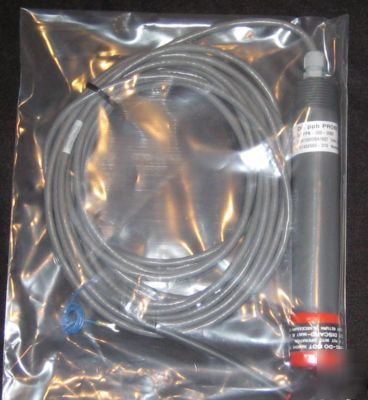____________________ > Abingdon
> System components
> Old Style
> Motor Components
> New honeywell DL5000 dissolved oxygen (d.o.) ppb probe
New honeywell DL5000 dissolved oxygen (d.o.) ppb probe
Honeywell DL5000 Dissolved Oxygen (D.O.) ppb Probe New!
Dissolved Oxygen (D.O.) ppb PVC Probe
* Normal Operating Temperature Range: 2 60 C (35.6 140 F)
* Storage Temperature: 2 60 C (35.6 140 F) (See Attention)
* Maximum Flow Rate: No dependence on stirring or flow. However, a minimal flow of 100 ml/min is expected to provide a flowing sample.
* for flow through mounting: 300 ml/min
* for in-line mounting: 5 gal/min (18.9 liter/min) in a 1 Schedule 40 Line
* for submersion mounting: Not applicable
* Maximum Pressure: 30 psi (207 kPa) for PVC probe
* Response time: 90% in 60 seconds (after Probe Warm-up)
* Probe Accuracy in parts per billion (ppb) measurements: 5% or 2 ppb whichever is greater at calibration conditions, after stabilization
* Probe Materials of Construction: PVC with a 20 ft. (6.1m) waterproof cable.
* Probe Dimensions: 8 .62 long X 1.315 OD (219 X 34 mm)
* Probe Weight: PVC 1.24 lb (0.6 kg)
The DL 5000 Dissolved Oxygen probe is based on a unique equilibrium probe technology. This patented equilibrium probe technology is based on the partial pressure of oxygen rather than the diffusion rate of oxygen through the probe membrane.
The materials of construction combined with this unique design result in a no-internal-maintenance probe that is independent of process flow and fouling because the anode is not consumed. Bottom line an accurate, reliable, maintenance-free, Dissolved Oxygen measurement requiring less recalibration.
The Honeywell probe is housed in PVC casing. One end has a 1 NPT male thread for mounting. The sensor extends from the housing and is covered by a protective guard (of the same material as the casing) which allows sample entry while preventing physical damage.
The probe has permanent electrolyte which is sealed at the rear with an expansion chamber to compensate for pressure changes. The sensor assembly is permanently potted into the housing and is not field replaceable. Operational service in wastewater applications should consist of an occasional wash to remove any large deposits at the sensor end. This can usually be accomplished without removing the protective guard. If the protective guard is removed, additional care must be taken to minimize the chance of puncturing a hole in the probe membrane. See Probe Maintenance section for proper cleaning procedures.
Physically the probe consists of three electrodes and a thermistor for temperature measurement and compensation. Two electrodes are interspaced on a supporting substrate and covered with an electrolyte; these electrodes are connected as anode and cathode. The third or reference electrode is mounted in the center of the electrode support and is also in contact with the electrolyte. The anode and cathode perform the oxygen generation and reduction functions while the reference electrode maintains the correct electrochemical potential.
Typical ppb applications include power plant and semi-conductor applications for corrosion detection or dearator efficiency. Typical ppm applications include aeration, effluent, stream and aquaculture monitoring for compliance and control.
* Unique equilibrium probe technology.
* Unaffected by fouling or changes in sample flow.
* Reduced maintenance costs - no periodic replacement of anode or electrolyte.
* Heavy duty membrane eliminates replacement requirements.
* Immersion, insertion or flow through mountings.
* Process temperature measurement, display and re-transmission with UDA2182
* Immersion, In-line and Flow-through attachments available.
* Simple time and cost effective Air Calibration initiated by UDA2182 or DirectLine software.
* Probe Bias test and optimization with UDA 2182.
* 20 foot (6.1m) analyzer to probe separation distance.
* Accessories for In-line and Flow-through applications.

